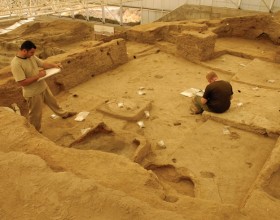 The United Nations Educational, Scientific and Cultural Organization (UNESCO) has decided to add Turkey’s Çatalhöyük, a Neolithic settlement in southern Anatolia, to UNESCO’s World Heritage List.
The United Nations Educational, Scientific and Cultural Organization (UNESCO) has decided to add Turkey’s Çatalhöyük, a Neolithic settlement in southern Anatolia, to UNESCO’s World Heritage List.
The site is an important example of the transition period in which villages were gradually transformed into urban centers. It contains 18 levels of Neolithic occupation, showing various cultural practices dating back to the Chalcolithic period, according to UNESCO’s website. With the addition of Çatalhöyük the number of sites in Turkey included on the UNESCO World Heritage List has increased to 11.
In addition to being an archeological site, Çatalhöyük is a major tourist attraction, featuring several wall paintings, sculptures and ornaments such as bracelets and necklaces, all of which can be seen by visitors. Testifying to a period of rich culture, the site also includes several Neolithic-era houses all standing very close to each other with roofs that serve as both windows and doors; the inhabitants seem to have entered their homes through the roof.
In May of last year, the Ministry of Culture and Tourism applied to UNESCO for several more historic and cultural sites to be added to the World Heritage Tentative List. Göreme National Park and the Rock Sites of Cappadocia, the Great Mosque and Hospital of Divriği, certain historic areas of İstanbul and the Hittite capital of Hattusha are among the historic and cultural sites currently on the World Heritage List.














